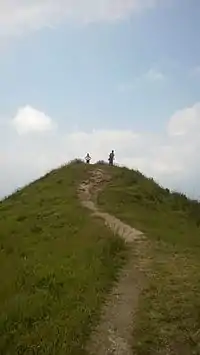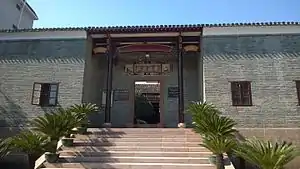Xingguo County
Xingguo County (simplified Chinese: 兴国县; traditional Chinese: 興國縣; pinyin: Xīngguó Xiàn) is a county in south central Jiangxi province, People's Republic of China. It is under the administration of and located in the north of the prefecture-level city of Ganzhou, with a total area of 3,214.46 km2 (1,241.11 sq mi). Its population was 719,830 at the 2010 census.[2]
Xingguo County
兴国县 Hingkwo | |
|---|---|
| Nickname(s): County of Generals (将军县)[1] | |
 Location of Xingguo County (red) in Jiangxi | |
| Coordinates: 26°20′02″N 115°20′46″E | |
| Country | People's Republic of China |
| Province | Jiangxi |
| Prefecture-level city | Ganzhou |
| Seat | Lianjiang (潋江镇) |
| Area | |
| • Total | 3,214.46 km2 (1,241.11 sq mi) |
| Dimensions | |
| • Length | 84 km (52 mi) |
| • Width | 71.5 km (44.4 mi) |
| Population (2010)[2] | |
| • Total | 719,830 |
| • Density | 220/km2 (580/sq mi) |
| Time zone | UTC+8 (China Standard) |
| Postal code | 342400 |
| Area code(s) | 0797 |
| Website | www |
History
In 236 during the Three Kingdoms period Pingyang County was set up in the current area of Xingguo County. In 982 during the Northern Song period the county of Xingguo was set up, named after the Taipingxingguo era (AD 976 – 984) of the emperor of that time.[1]
Administration
As of end of 2019, Xingguo has jurisdiction over 8 towns, 17 townships and 1 economic development zone.[3] The seat of the county locates at the Lianjiang Town.
- 8 towns
|
|
- 17 townships
|
|
Geography

Location
Xingguo County locates in the central south of Jiangxi Province, and in the north of Ganzhou prefectural level city. The distance to the center of Ganzhou is about 82 kilometers, and the distance to the provincial capital Nanchang is about 346 kilometers.

Topography
The length from east to west is 84 kilometers and the width from north to south is 71.5 kilometers. Xingguo is mostly covered by hills and mountains: mountains over 1000 meters on the east, north and west edges, while hilly areas in the center and south parts, with a small basin around the county seat Lianjiang Town. The highest point is the Mount Dawushan at Fengbian Township in the north with elevation of 1204 meters, while the lowest point locates at Mubu Village, Longkou Township in the south with elevation of 127.9 meters.[4]
Rivers
The rivers in Xingguo are mostly tributaries to Gong River,[4] which forms Gan River together with Zhang River near the city center of Ganzhou.
There are several reservoirs in Xingguo, the largest one being Changgang Reservoir at Changgang Township.
Climate
Xingguo has a humid subtropical climate. The annual average temperature is 18.8 °C, and the average annual precipitation is 1515.6 mm.[4]
Demographics
According to the official website, the population in 2015 was about 820,000.[5] Xingguo is Hakka area, the ancestors of the population mostly came from Henan, Gansu and other provinces such as Shaanxi, Hebei, Shanxi and Shandong.[1]
There are a small number of She people living in Xingguo. According to the records, there were 810 households and 4419 She people in 1986.[6] Four villages in Xingguo are designated to She people.
Places of interests



The Revolutionary Sites of Xingguo is on the list of Major Historical and Cultural Sites Protected at the National Level. It includes 5 different sites where Mao Zedong, Communist Party, and Red Army had had activities during 1929 - 1933.[7] As a result of these activities, there has been 54 persons from Xingguo appointed as major generals, lieutenant generals, or colonel generals in the army (later additional 2 persons were appointed). So Xingguo is nicknamed as the County of Generals.[1]
In addition, there are 19 historical and cultural sites protected at the provincial level,[8] 9 sites at the prefectural city level, and 25 sites at the county level.[7]
- Lianjiang Academy: Built in 1738 as an academy of classical learning. Mao Zedong held the training class for cadre on land reforms here in 1929. Later it functioned as the seat of the Soviet government of Xingguo County from 1930 to 1934. Protected at the national level as a part of the Revolutionary Sites of Xingguo.
- Zhuhua Pagoda: Initially built during the Tang dynasty, later rebuilt in 1550 during the Ming dynasty. The central pillar is in square shape, which is quite uncommon among pagodas. Protected at the provincial level.
- Inscription "Yongzhen Jiangnan" ("Eternally safeguarding the south of Yangtze") by Wen Tianxiang: It locates in a temple at the top of Mount Dawushan. Protected at the provincial level.
- Bingxin Cave: Scenery with Danxia landform.
- Taipingyan Cave: A cave in Karst landscape area in Meijiao Town.
Transportation
Highways and roads
- Expressways of China: G72 Quanzhou–Nanning Expressway, Xingguo–Ganxian Expressway
- China National Highways: G238, G319, G356
- Provincial roads: S227, S229
Railway
- Beijing–Kowloon Railway
- Nanchang-Ganzhou High Speed Rail (under construction)
- Xingguo-Quanzhou Railway (under construction)
Culture
Hakka culture
Xingguo is a settlement for Hakka people, so it has the characteristics of Hakka culture, including the Hakka Chinese language.
Folk song
In Xingguo there is a unique folk song genre called Xingguo Shan'ge (mountain song).
Notable people
- Colonel generals: Chen Qihan, Xiao Hua
- Lieutenant general: Qiu Huizuo
- Politicians: Guo Shengkun, Wang Taihua, Yang Shangkui, Zeng Qinghong
Cuisine and specialities
- Xingguo red carp[9]
- Steamed and dried sweet potato[9]
- Xingguo fish noodle: made from fish meat and sweet potato powder.[9]
- Fen long chuang: fish or meat covered by sweet potato powder, together with spicy taro or sweet potato slices and rice noodles, steamed in a big bamboo case. Together with 4 small dishes, Mao Zedong named it as Si xing wang yue (fours stars gazing at the moon).[10]
References
- "历史沿革". xingguo.gov.cn (in Chinese). 2014-04-14. Retrieved 2016-03-21.
- "GÀNZHŌU SHÌ (Prefecture-level City)". citypopulation.de. Retrieved 2016-03-21.
- "行政区划". www.ganzhou.gov.cn (in Chinese). 2019-05-07. Retrieved 2020-10-21.
- "自然资源". xingguo.gov.cn (in Chinese). 2014-04-14. Retrieved 2016-03-21.
- "兴国县简介". xingguo.gov.cn (in Chinese). 2015-03-11. Retrieved 2016-03-21.
- Hu Yuchun (2015-12-25). "兴国畲族历史考(一)". xingguoxian.cn (in Chinese). Retrieved 2016-03-21.
- "文物保护——兴国县各级文物保护单位名单". jxxggmjng.com (in Chinese). 2013-10-28. Retrieved 2016-03-21.
- "我县新增13处省级文物保护单位". xingguo.gov.cn (in Chinese). 2018-03-29. Retrieved 2018-07-01.
- "资源特产". xingguo.gov.cn (in Chinese). Retrieved 2016-03-21.
- ""四星望月"——毛泽东命名的客家菜". xgjjw.com (in Chinese). Retrieved 2016-03-21.
External links
| Wikimedia Commons has media related to Xingguo County. |